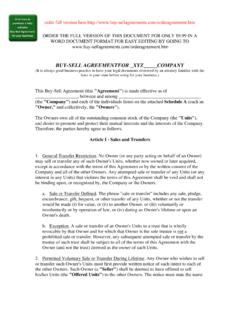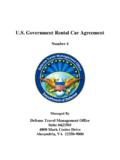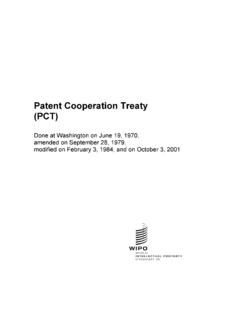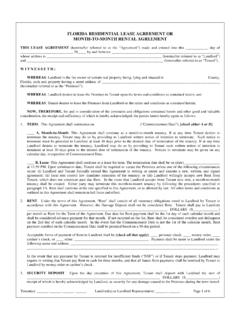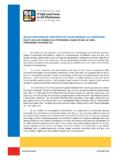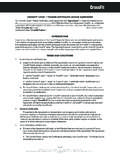Transcription of FARMLAND AND OPEN SPACE Farmland …
1 FARMLAND AND OPEN SPACE PRESERVATION PROGRAM Part 361 of the Natural Resources and Environmental Protection Act, 1994 Act 451 as amended, more commonly known as PA 116. FARMLAND Agreement Application ELIGIBILITY & INSTRUCTIONS Please review the following eligibility requirements and instructions before completing an application for a FARMLAND Agreement. If your farm (including the residence and farm buildings) meets one of the following criteria, it is eligible for enrollment in the program under Part 361 of the Natural Resources and Environmental Protection Act, 1994 Act 451 as amended, more commonly known as PA 116. I. As defined by the Act, agricultural use means: The production of plants and animals useful to humans, including forages and sod crops; grains, feed crops and field crops; dairy and dairy products; poultry and poultry products; livestock, including breeding and grazing of cattle, swine, captive cervidae, and similar animals; berries; herbs; flowers; seeds; grasses; nursery stock; fruits; vegetables; maple syrup production; Christmas trees; and other similar uses and activities.
2 Agricultural use includes use in a federal acreage set-aside program or a federal conservation reserve program. Agricultural use does not include the management and harvesting of a woodlot. As defined by the Act, FARMLAND means: 1. A farm of 40 or more acres in one ownership, with 51% or more of the land area devoted to an agricultural use. 2. A farm of 5 acres or more in one ownership, but less than 40 acres, with 51% or more of the land area devoted to an agricultural use, that has produced a gross annual income from agriculture of $ per year or more per acre of cleared and tillable land. A farm described in this subparagraph enrolled in a federal acreage set aside program or a federal conservation reserve program is considered to have produced a gross annual income from agriculture of $200 per year or more per acre of cleared and tillable land. 3. A farm designated by the department of agriculture as a specialty farm in one ownership that has produced a gross annual income from an agricultural use of $2, or more.
3 Specialty farms include, but are not limited to, greenhouses; equine breeding and grazing; the breeding and grazing of cervidae, pheasants, and other game animals; bees and bee products; mushrooms; aquaculture; and other similar uses and activities. 4. Parcels of land in one ownership that are not contiguous but which constitute an integral part of farming operations being conducted on land otherwise qualifying as FARMLAND may be included in an application under this part. II. The administrative rules providing for the administration and implementation of the program further define the following: 1. Gross annual income means an average computed from two of the three tax years immediately preceding the year of application from the raising or harvesting of any agricultural commodities. 2. Specialty farm means an enterprise of 15 or more acres in size which meets the income requirement and has been designated by the Michigan Department of Agriculture.
4 III. A FARMLAND development rights agreement is a temporary restrictive covenant where the owner and the state agree to jointly hold the right to develop a parcel of FARMLAND . The covenant is an agreement to not develop the property except as specifically stated within the agreement. The covenant runs with the land and is for a jointly agreed upon length of time (at least 10 years). A FARMLAND development rights agreement contains the following restrictions: 1. A structure shall not be built on the land except for use consistent with farm operations, which includes a residence for an individual essential to the operation of the farm as defined under section 36110(5), or lines for utility transmission or distribution purposes or with the approval of the local governing body and the state land use agency. 2. Land improvements shall not be made except for a use consistent with farm operations or with the approval of the local governing body and the state land use agency.
5 3. Any interest in the property shall be sold only for a scenic, access, or utility easement which does not substantially hinder farm operations. 4. Public access shall not be permitted on the land except with the permission of the owner. 5. Any other condition or restriction on the land as agreed to by the parties that is considered necessary to preserve the land or appropriate portions of it as FARMLAND . Instructions for Completing FARMLAND Agreement Application: Please print or type in all spaces required on the application form. PLEASE NOTE: The application form must be filed with the clerk of the local governing body having jurisdiction over the land cited in the application. Those local governing bodies having the right of approval or rejection of an application are defined by the Act as either: (a) the legislative body of a city or village; or (b) the township board of a township having a zoning ordinance in effect as provided by law; or (c) the county board of commissioners in all other areas.
6 SPECIAL SITUATIONS: 1. Owning more than one farm unit: To make it less complicated for an owner wishing to place more than one farm unit into the program, it is recommended that the owner fill out separate applications for each farm unit over 40 acres. If all of the forms will be submitted to one local governing body having approval authority, it is suggested that the applications be filed together at the same time. 2. Owning more than one farm unit located in different local governing bodies having approval authority: If the farm units fall under different local governing bodies having approval authority, it is suggested that the applicant attach a statement to each application indicating that more than one application has been filed by the owner and a list of the local governing bodies involved. 3. One contiguous farm unit having more than one legal description: Those owners having one contiguous farm unit with more than one tax parcel description (deed) for portions of the farm, but wishing to place the entire farm into the program, may attach copies of all the descriptions and fill out the application as if the farm was under one deed.
7 4. Having one farm unit located in different local governing bodies having approval authority: In the case of an owner having one contiguous farm unit which crosses the boundaries of more than one local governing body having approval authority, the applicant must file separate applications covering the land located in the respective local governing bodies jurisdictions and attach a statement indicating that more than one application has been filed by the landowner and a list of the local governing bodies involved. 5. Landowners need not apply for all their property. However, the landowner is responsible for furnishing an accurate legal description of land covered by the application. If the landowners wish to exclude some portion of a description, they must provide a description which excludes the acreage they desire to withhold. An approved application is forwarded by the local governing body to the state land use agency for approval or rejection by the state.
8 An applicant receiving a rejection from a local governing body can appeal within 30 days of the rejection notice to the state land use agency for a decision, or the applicant may wait one year and reapply for enrollment in the program. I. Personal information: (1-5) Owner is defined by the Act as a person having a freehold estate in land coupled with possession and enjoyment . Person , as defined in the Act, includes an individual, corporation, limited liability company, business trust, estate, trust, partnership, association or 2 or more persons having a joint or common interest in the land If more than one name is involved (excluding husband and spouse), please attach additional sheet listing necessary names and information required in blanks 1 through 5. Only the owner(s) of land cited within the application may apply to enroll land into the program. Married persons filing either a joint or separate Michigan state income tax return must indicate Social Security numbers.
9 The federal employee identification number is applicable only to those corporations, sub- chapter S corporations, partnerships or individuals who must withhold taxes for their employees. II. Property Location: (6-8) The applicant must indicate the county and township, city or village where the land cited in the application is located. The section number, town number and range number can be found on the deed to the land. III. Legal Information: (9) The applicant must attach a clear copy of the deed from the county register of deed s office. Land contract purchasers should send a copy of the land contract or memorandum of land contract. (10) The applicant must attach a copy of the most recent property tax assessment notice or tax bill including a complete tax description of the property. Land contract purchasers who do not receive a property tax assessment notice or tax bill may obtain a copy from the assessor.
10 (12) Mineral rights would include oil, gas, coal, iron ore, gravel, etc. (13) Any land subject to a rental or lease agreement not directly associated or consistent with farm operation is prohibited from being included in the program. Examples which must be excluded are: a second residence being rented to someone not connected with the farm operation; land being used as parking or storage for materials not associated with that particular farm operation, a leased landing strip, etc. (14) The Act states that where land is subject to a land contract, it means the vendor (seller) in agreement with the vendee (purchaser). Whether the applicant is the seller or the purchaser, the applicant must have the consent of the other party to place land subject to a land contract into the program. (15) This section of the application is only applicable to those owners who fall within the described categories for income tax information.










